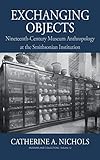Exchanging Objects : Nineteenth-Century Museum Anthropology at the Smithsonian Institution / Catherine A. Nichols.
Material type: TextSeries: Museums and Collections ; 12Publisher: New York ; Oxford : Berghahn Books, [2021]Copyright date: ©2021Description: 1 online resource (268 p.)Content type:
TextSeries: Museums and Collections ; 12Publisher: New York ; Oxford : Berghahn Books, [2021]Copyright date: ©2021Description: 1 online resource (268 p.)Content type: - 9781800730526
- 9781800730533
- ART / Museum Studies
- 19th century
- anthropology
- appropriation
- archival
- art collectors
- art
- career
- classifying objects
- collections catalogs exhibitions
- contemporary museum work
- deaccessioning
- duplicate specimens
- engaging
- exchange
- historical account
- history
- local institutions
- museum curators
- museum exchanges
- museum objects
- museum professionals
- museum studies
- museums
- page turner
- realistic
- schools
- smithsonian institution
- technical requirement
- 306.074753 23/eng/20230216
- online - DeGruyter
| Item type | Current library | Call number | URL | Status | Notes | Barcode | |
|---|---|---|---|---|---|---|---|
 eBook
eBook
|
Biblioteca "Angelicum" Pont. Univ. S.Tommaso d'Aquino Nuvola online | online - DeGruyter (Browse shelf(Opens below)) | Online access | Not for loan (Accesso limitato) | Accesso per gli utenti autorizzati / Access for authorized users | (dgr)9781800730533 |
Frontmatter -- Contents -- List of Illustrations and Tables -- Acknowledgments -- List of Abbreviations -- Chronology. Lists of Relevant Smithsonian Institution/ US National Museum Personnel -- Introduction. A Bowl’s Journey, There and Back Again -- Part I. The Museum through the Lens of Specimen Exchange -- Chapter 1. The Smithsonian and the Museum: Specimen Exchange as a Bridge between Joseph Henry’s Research Institution and Spencer Baird’s Grand Cabinet -- Chapter 2. Spencer Baird’s US National Museum and Early Trends in Exchanging Anthropological Duplicates (1861–1880) -- Chapter 3. Networking the US National Museum: Exchanging Anthropological Duplicates (1882–1920) -- Chapter 4. Giving and Receiving: Specimen Exchange between Curators, and the Shaping of Anthropological Collections -- Part II. The Duplicate -- Chapter 5. Duplicates: Specimens in Motion -- Chapter 6. Catalogs, Classifi cation, and Contingency: Designating Duplicates -- Conclusion. Museum Pasts and Futures -- Appendix. Smithsonian Institution/USNM Table of Distributed Specimens (1854–1880) -- Bibliography -- Index
restricted access online access with authorization star
http://purl.org/coar/access_right/c_16ec
As an historical account of the exchange of “duplicate specimens” between anthropologists at the Smithsonian Institution and museums, collectors, and schools around the world in the late nineteenth century, this book reveals connections between both well-known museums and little-known local institutions, created through the exchange of museum objects. It explores how anthropologists categorized some objects in their collections as “duplicate specimens,” making them potential candidates for exchange. This historical form of what museum professionals would now call deaccessioning considers the intellectual and technical requirement of classifying objects in museums, and suggests that a deeper understanding of past museum practice can inform mission-driven contemporary museum work.
Mode of access: Internet via World Wide Web.
In English.
Description based on online resource; title from PDF title page (publisher's Web site, viewed 25. Jun 2024)


